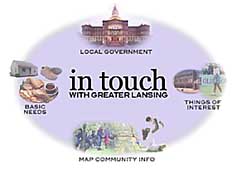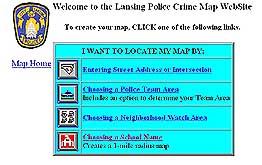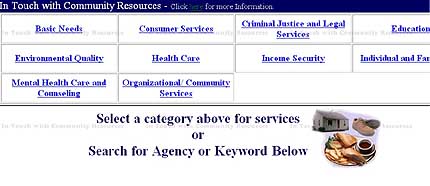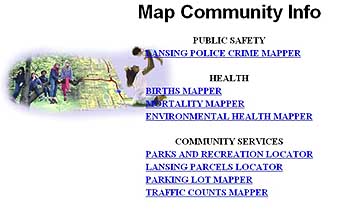
Click here for a larger image
"In Touch"
Neighborhood Stabilizing Data Improving Low Income Citizens Quality of Life

Click here for a larger image
Lansing Police Department began their Community Policing efforts in 1990. As the program and philosophy evolved the Department recognized a critical need to better communicate crime and health as well as basic social service needs to community members. Therefore, in 1998, under the direction of Mayor David Hollister, the Police Department reviewed the various experiences it had learned implementing Community Policing and created a method to better facilitate communication to the citizens of Lansing. The method developed was a seamless network between the police problem solving teams, various service providers and community members. A digital link was developed which provides all Lansing and Tri-County area residents access to information related to the following: crime and neighborhood problems, health care, and basic needs such as food, housing and clothing.
We identified three specific areas that this project needed to address.
1. Crime and neighborhood problems
There was a substantial need for expanding communication between residents, Lansing Police Department problem solving teams and service providers. Each of these entities were networked for seamless interaction and communication among the various users and service providers. This enables residents to directly communicate with the police problem solving teams and identify resources readily available to them. Community members can also look at the crime problems that affect them using a MO-IMS GIS application showing current crime trends by team area, school and precinct.

Click here for a larger image
2. Health care
Provide easy access to identifiable health care including environmental, nutritional and behavioral health. Information on local hospitals, health care agencies, State and Federal programs along with community based health centers were all included in the Information and Referral data base. A GIS MO-IMS application was placed on the web so users could choose their search and content capabilities based on experience.
3. Basic needs
There was a need for all Tri-County families to easily access essential services and information concerning basic needs such as food, housing and clothing. These service providers had no viable resource to reach the low income families they wished to serve. In addition, service providers had needs in terms of volunteers, donated food, household furniture, etc. Individuals seeking to serve and be served at various agencies are now able to access a system that links them to service providers.
The way we increased communication was by constructing a City wide Internet accessible e-mail system and made it searchable by the Community, Police, City and County web sites. To coordinate and increase accessibility of service providers, we implemented an Information Referral Database available through the Internet. This allows anyone with Internet access the ability to connect to nearly all Tri-County services.
In order to enhance the users ability to identify neighborhood problems we implemented a Geographic Information System. This system was populated with reported crime locations, parks locations, parcel mapping for identification of registered rental properties, and County health data such as births and deaths, and various environmental hazard layers.
The City collaborated with numerous government and private agencies to provide Lansing area residents with democratized data, which puts public information on the Internet for community members to use. Two web sites were built for the community using grant funding from the U.S. Department of Commerce and Kellogg Foundation. The Department of Commerce Intouchlansing.com site features information on both the City of Lansing and Ingham County and provides the following information:
• Information and Referral (I&R) database - This attaches users to resources by allowing them to search over 600 agencies that provide basic services such as food, shelter and clothing. Search criteria include agency name, keyword and service provided. Each listing provides contact information, agency hours and exact services provided. Users are then able to map directions from their address to the agency.

Click here for a larger image
• Geographic Information System (GIS) mapping
A) For Crime Data - Residents are provided with contact information, including phone number and e-mail to Police Problem Solving Teams. Citizens can contact their teams to provide information that may lead to the solving of a crime in their neighborhood resulting in a stronger partnership between residents and problem solving teams. Residents can search for crime information by street address, police problem solving team area, neighborhood watch area and proximity to a nearby school. Data is also searchable by date and type of crime committed.
B) For Health Data - Citizens can search for information on births or deaths by street address, specific date, population or cause of death.

Click here for a larger image
• Links to City and County Government - This includes links to Lansing and Ingham County government departments and tourism information.
Capital Area Community Voices (cacvoices.org) was developed by several area corporations, agencies and government departments. Some of these include the Ingham County Health Department, Sparrow Health System, Ingham Regional Medical Center and the City of Lansing. CACVoices shares many of the same features of intouchlansing.com, including crime and health mapping and the information and referral database, but is focused on the health and well being of residents in the tri-county area. Features unique to cacvoices.org include;
• Indicators of Well Being - This utility compares trends in indicators of access to the following health areas:
• Community Forum - Site users can participate in online chats concerning community and environmental health, and can view comments other users have made.
• Community Data- Provides links to intouchlansing.com 's crime and health mapping utility and Information & Referral database, and also includes vital statistics and surveys for the community and links to numerous other health organizations.
• Document Warehouse - Users can search for articles posted on the site by title using author and date added.
• Community Voices - Contains articles related to African American health as well as other health issues.
Site developers anticipated several outcomes from both sites:
• The building and strengthening of relationships and communication between citizens and government.
• An increased sense of community involvement for residents of the Lansing area.
• Improved economic vitality of neighborhoods.
• An awareness of community health issues and improvement in access to health care. Citizens without access to a computer may use any of the 48 computers that have been distributed to the community. (The computers and printers were placed within low income, high residential neighborhoods so residents would have free access to the various resources of the two web sites.)
Contact Person:
For information about InTouchLansing contact Lt. Steve Person at the Lansing Police Department, (517) 483-4647, techlt@lansingpolice.com.